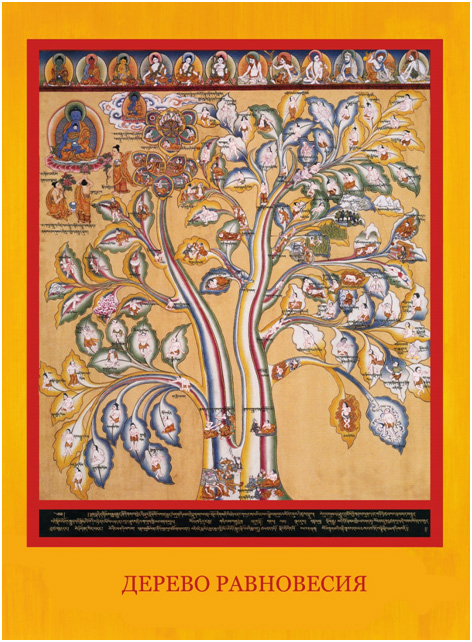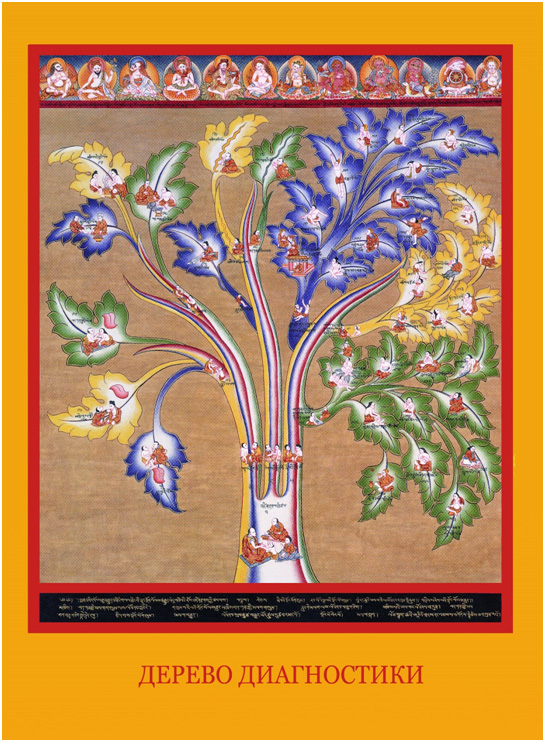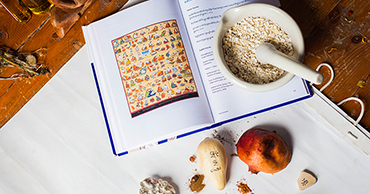You have no items in your shopping cart.
The Trees of Tibetan Medicine
The fundamental medical treatise, the rGyud-bZhi, is comprised of four sections, usually known as the Four Tantras:
- The Root Tantra
- The Explanatory Tantra
- The Oral Instruction Tantra and
- The Last/Subsequent Tantra.
The complete text encompasses 5900 verses which are grouped into 156 chapters.
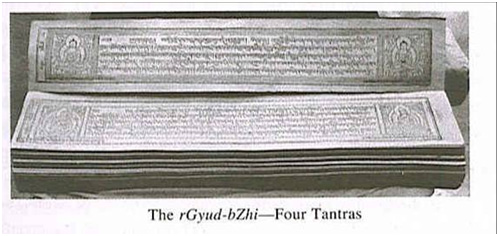
The Root Tantra
The first section, the Root Tantra, is comprised of six chapters giving a brief outline of the whole text and comparing the medical system with a tree. Three roots sprout into nine stems, which branch out into 47 branches bearing 224 leaves. The nine stems represent the nine sections of medical science, the branches stand for general information and the leaves illustrate the details.
The First root - Health and Disease
The first root explains the human organism and its functioning and encompasses two stems, which stand for the healthy and the sick body. The healthy body is represented by three branches and 25 leaves, the sick body by nine branches and 63 leaves. The first stem, the healthy body, bears three branches. One of the branches represents the three humours, the other represents bodily constituents (nutritional essence, blood, muscle tissue, fat or fatty tissue, bones, marrow and regenerative fluid) and the third branch the three excretions of the body (faeces, urine and perspiration).
Furthermore, the first stem bears two flowers standing for health and long life and three fruits representing religion, wealth and happiness.
The second stem represents the sick body. This section deals with the three causes, the four conditions, the six different entrances, the locations and the fifteen pathways of the diseases. The association of advancement of diseases with the patient’s age, the seasons and the place where the patient resides is also discussed. Furthermore, the nine fatal disorders, the twelve contraindications due to inappropriate treatment and the condensation of all the disorders into hot and cold nature are also stated.
The Second root - Diagnosis
The second root informs about the methods of diagnosis, the examination of the tongue and urine, the pulse diagnosis and the questioning of the patient regarding the symptoms of the disease, the way of living, etc.
This illustration displays three stems and depicts the three main diagnostic techniques used by Tibetan physicians: pulse reading, urine analysis and interrogation. The first stem deals with visual observation methods. It is divided into two branches; the first branch stands for observation of the tongue and the other branch for urine analysis. These branches possess three leaves each, showing that each of the three humours has a different effect on the patient's tongue and urine, which can be visually detected by the physician.
The second stem depicts the pulse analysis in three branches each comprising of a single leaf symbolising the different pulse natures of the three humours.
The third stem deals with the method of interrogation. It consists of three branches with 11 blue leaves relating to rlung disorders, seven yellow leaves relating to mkhris-pa disorders and 11 white leaves to bad-kan disorders. These colours stand for the different ways of inquiring used to identify the humoral diseases and their symptoms as well as to determine their remedies.
The Third root - Treatment
This picture shows the methods of treatment used in the Tibetan system of medicine. The root of treatment develops into four stems symbolising diet, behaviour, medication and external therapy. These treatments are generally used in combination depending on the nature of the person and the disease involved.
The first stem stands for diet treatment, which has six branches. The first two branches with ten and four blue leaves, respectively, show the diet and the drink best suited to treat rlung disorders. The third and fourth branches with seven and five yellow leaves, respectively, stand for the diet and drink suitable for mkhris-pa disorders and the fifth and sixth branches with six and three white leaves, respectively, stand for the diet and drink recommended for bad-kan disorders.
The second stem illustrates behavioural treatment. It has three branches with two leaves each representing the behaviours beneficial for the three humours.
The third stem depicts the different medications. It has a total of 15 branches and 50 leaves. The first six branches each bear three leaves. These refer to the tastes and medicinal qualities favourable for treating rlung, mkhris-pa and bad-kan disorders, which are shown as blue, yellow and white leaves, respectively.
The seventh to the twelfth branches bear a total of 23 leaves representing different medicinal preparations: broth and medicinal butter, decoctions and powders, pills and specific medicinal powders. The type of preparation prescribed depends on the afflicted humour. In addition to the above medications, there are three different branches symbolising medicinal preparations with a cleansing effect: enemas, purgatives and emetics used respectively for rlung, mkhris-pa and bad-kan disorders. They are represented by three blue leaves on the thirteenth branch, four yellow leaves on the fourteenth and two white leaves on the fifteenth branch. The fourth stem stands for external therapies, which are generally used as a last resort after all other treatments fail. It consists of three branches. The two blue leaves on the first branch portray the external therapy used to treat rlung disorders. The three yellow leaves on the second branch stand for external therapies used to fight mkhris-pa disorders and the two white leaves on the third branch signify external therapies used on bad-kan disorders.
The Explanatory Tantra
The second Tantra, the Explanatory Tantra, encompasses 31 chapters and is concerned with the life cycle (conception, childbirth, functioning of the three humours and signs of death), causes, conditions and classification of the diseases. It specifies the properties of medicinal ingredients and explains in detail diet, behaviour and the rules for maintaining health, etc. It also contains a code which the physicians should up-hold in conducting his profession.
The Oral Tradition Instruction Tantra
The third Tantra, the Oral Tradition Tantra, consists of 92 chapters which mainly teach the 101 disorders of the three humours indicating their causes, conditions, symptoms and methods of therapy.
The Subsequent / Last Tantra
The fourth tantra, the Last Tantra, is comprised of 27 chapters, which deal with diagnosis (such as urine analysis and pulse reading), pacifying medicinal ingredients and their preparations (pills, powders, syrups, medicinal butters, etc.) evacuative medications (purgatives and emetics) and additional treatments (moxibustion, golden-needle therapy).
Illustrations for “Four Tantras”
The great Master, father of Tibetan Medicine, Yuthog The Elder (729-854), wrote “Four Tantras” that is in fact the student book , thereby established the first standard educational system which still exist in Tibet.
Later, in 17th century the minister of HH the 5th Dalai Lama, Desi Sangye Gyatso (1653-1705), created a famous «Blue Beryl» and Atlas of Tibetan Medicine, a commentary, containing approximately 80 thanghkas (scroll paintings) illustrating “Four Tantras”.
Desi Sangye Gyatso paid special attention to paintings: they show illustrations to many educated lamas and physicians to exclude any mistakes. Fist, after several years of work, there were made only 50 sheets, than arises till 62, but in 1703 Desi Sangye Gyatso named 79 sheets.
Destiny of this, original illustrations is unknown.
During this three centuries, "Atlas" had been copied only few times.The most full copy, made in 19th century is stored in National Museum of Buryatia, Russia.
In XX century some sheets of Atlas were re-drew in accordance to new knowledge.
Tibetan Tree’s drawings could be found in museums and private collections:
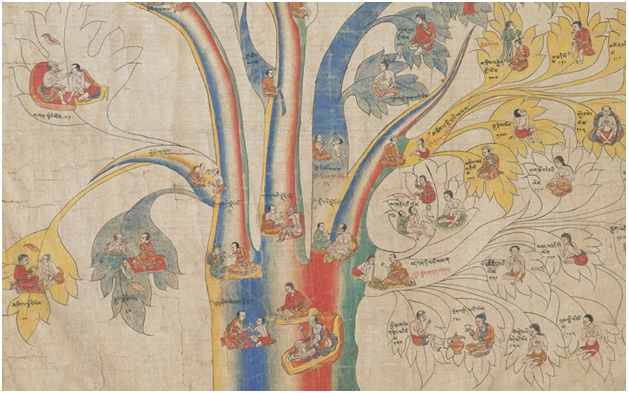
"Tree of Diagnosis, Tibet or Mongolia," 18th or 19th century, pigments on cloth and brocade,
Pritzker Collection. Rubin Museum of Art
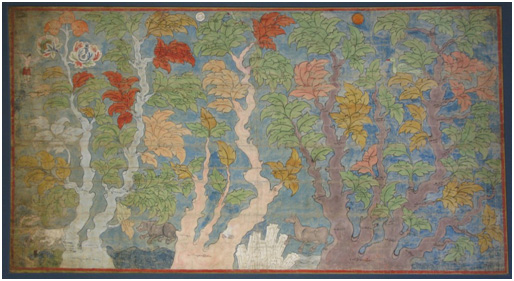
“Three Roots” Rubin Museum of Art, USA
Trees of Tibetan Medicine from “Blue Beryl” Atlas, national museum Buryatia
